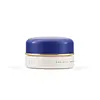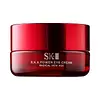What's inside
What's inside
 Key Ingredients
Key Ingredients

 Benefits
Benefits

 Concerns
Concerns

 Ingredients Side-by-side
Ingredients Side-by-side

Water
Skin ConditioningGlycerin
HumectantSqualane
EmollientPropanediol
SolventXylitol
HumectantGlyceryl Stearate Se
EmulsifyingCyclopentasiloxane
EmollientBehenyl Alcohol
EmollientMyristyl Myristate
EmollientSilica
AbrasiveBeeswax
Emulsion StabilisingPaeonia Albiflora Root Extract
Skin ConditioningCamellia Japonica Seed Oil
EmollientCamellia Sinensis Leaf Extract
AntimicrobialLonicera Japonica Leaf Extract
Skin ConditioningCoix Lacryma-Jobi Ma-Yuen Seed Extract
Skin ConditioningChondrus Crispus Extract
Skin ConditioningInositol
HumectantSodium Hyaluronate
HumectantTocopheryl Acetate
AntioxidantCaprylyl/Capryl Glucoside
CleansingCaprylic/Capric/Myristic/Stearic Triglyceride
EmollientTetrasodium Pyrophosphate
BufferingDisodium EDTA
Sodium Acrylate/Acryloyldimethyltaurate/Dimethylacrylamide Crosspolymer
Emulsion StabilisingSodium Dilauramidoglutamide Lysine
HumectantIsostearic Acid
CleansingSorbitan Isostearate
EmulsifyingEthylhexylglycerin
Skin ConditioningAluminum Hydroxide
EmollientParfum
MaskingStearyl Alcohol
EmollientAlcohol
AntimicrobialPhenoxyethanol
PreservativeCI 77891
Cosmetic ColorantCI 77491
Cosmetic ColorantWater, Glycerin, Squalane, Propanediol, Xylitol, Glyceryl Stearate Se, Cyclopentasiloxane, Behenyl Alcohol, Myristyl Myristate, Silica, Beeswax, Paeonia Albiflora Root Extract, Camellia Japonica Seed Oil, Camellia Sinensis Leaf Extract, Lonicera Japonica Leaf Extract, Coix Lacryma-Jobi Ma-Yuen Seed Extract, Chondrus Crispus Extract, Inositol, Sodium Hyaluronate, Tocopheryl Acetate, Caprylyl/Capryl Glucoside, Caprylic/Capric/Myristic/Stearic Triglyceride, Tetrasodium Pyrophosphate, Disodium EDTA, Sodium Acrylate/Acryloyldimethyltaurate/Dimethylacrylamide Crosspolymer, Sodium Dilauramidoglutamide Lysine, Isostearic Acid, Sorbitan Isostearate, Ethylhexylglycerin, Aluminum Hydroxide, Parfum, Stearyl Alcohol, Alcohol, Phenoxyethanol, CI 77891, CI 77491
Water
Skin ConditioningGlycerin
HumectantGalactomyces Ferment Filtrate
HumectantNiacinamide
SmoothingIsohexadecane
EmollientButylene Glycol
HumectantPentylene Glycol
Skin ConditioningIsopropyl Isostearate
EmollientPetrolatum
EmollientDimethicone
EmollientCaprylic/Capric Triglyceride
MaskingVinyl Dimethicone/Methicone Silsesquioxane Crosspolymer
Polyacrylamide
Phytosteryl/Behenyl/Octyldodecyl Lauroyl Glutamate
Skin ConditioningStearyl Alcohol
EmollientCetyl Alcohol
EmollientC13-14 Isoparaffin
EmollientBehenyl Alcohol
EmollientTocopheryl Acetate
AntioxidantPolymethylsilsesquioxane
Panthenol
Skin ConditioningNylon-12
Benzyl Alcohol
PerfumingDimethiconol
EmollientMethylparaben
PreservativePEG-100 Stearate
Laureth-7
EmulsifyingCetearyl Glucoside
EmulsifyingCetearyl Alcohol
EmollientStearic Acid
CleansingMica
Cosmetic ColorantDisodium EDTA
Propylparaben
PreservativeSodium PEG-7 Olive Oil Carboxylate
EmulsifyingEthylparaben
PreservativePEG-7 Glyceryl Cocoate
EmulsifyingChlorella Vulgaris Extract
Skin ConditioningSodium Hydroxide
BufferingHydrolyzed Lupine Protein
Skin ConditioningDecyl Glucoside
CleansingMedicago Sativa Extract
TonicPhenoxyethanol
PreservativeLactic Acid
BufferingSodium Benzoate
MaskingHydrolyzed Soy Protein
HumectantPolyquaternium-7
Tin Oxide
AbrasiveEthylhexylglycerin
Skin ConditioningPalmitoyl Dipeptide-7
Skin ConditioningHydrolyzed Yeast Protein
Skin ConditioningAcanthopanax Senticosus Root Extract
Skin ConditioningPalmitoyl Pentapeptide-4
Skin ConditioningMethylsilanol Tri-PEG-8 Glyceryl Cocoate
EmulsifyingAmmonium Polyacrylate
StabilisingMethicone
EmollientTocopherol
AntioxidantCynara Scolymus Leaf Extract
Skin ConditioningBHT
AntioxidantParfum
MaskingLimonene
PerfumingLinalool
PerfumingCI 77891
Cosmetic ColorantCI 77492
Cosmetic ColorantWater, Glycerin, Galactomyces Ferment Filtrate, Niacinamide, Isohexadecane, Butylene Glycol, Pentylene Glycol, Isopropyl Isostearate, Petrolatum, Dimethicone, Caprylic/Capric Triglyceride, Vinyl Dimethicone/Methicone Silsesquioxane Crosspolymer, Polyacrylamide, Phytosteryl/Behenyl/Octyldodecyl Lauroyl Glutamate, Stearyl Alcohol, Cetyl Alcohol, C13-14 Isoparaffin, Behenyl Alcohol, Tocopheryl Acetate, Polymethylsilsesquioxane, Panthenol, Nylon-12, Benzyl Alcohol, Dimethiconol, Methylparaben, PEG-100 Stearate, Laureth-7, Cetearyl Glucoside, Cetearyl Alcohol, Stearic Acid, Mica, Disodium EDTA, Propylparaben, Sodium PEG-7 Olive Oil Carboxylate, Ethylparaben, PEG-7 Glyceryl Cocoate, Chlorella Vulgaris Extract, Sodium Hydroxide, Hydrolyzed Lupine Protein, Decyl Glucoside, Medicago Sativa Extract, Phenoxyethanol, Lactic Acid, Sodium Benzoate, Hydrolyzed Soy Protein, Polyquaternium-7, Tin Oxide, Ethylhexylglycerin, Palmitoyl Dipeptide-7, Hydrolyzed Yeast Protein, Acanthopanax Senticosus Root Extract, Palmitoyl Pentapeptide-4, Methylsilanol Tri-PEG-8 Glyceryl Cocoate, Ammonium Polyacrylate, Methicone, Tocopherol, Cynara Scolymus Leaf Extract, BHT, Parfum, Limonene, Linalool, CI 77891, CI 77492
 Reviews
Reviews

Ingredients Explained
These ingredients are found in both products.
Ingredients higher up in an ingredient list are typically present in a larger amount.
Behenyl Alcohol is a type of fatty alcohol (these are different from the drying, solvent alcohols).
Fatty Alcohols have hydrating properties and are most often used as an emollient or to thicken a product. They are usually derived from natural fats and oils; behenyl alcohol is derived from the fats of vegetable oils.
Emollients help keep your skin soft and hydrated by creating a film that traps moisture in.
In 2000, Behenyl Alcohol was approved by the US as medicine to reduce the duration of cold sores.
Learn more about Behenyl AlcoholCi 77891 is a white pigment from Titanium dioxide. It is naturally found in minerals such as rutile and ilmenite.
It's main function is to add a white color to cosmetics. It can also be mixed with other colors to create different shades.
Ci 77891 is commonly found in sunscreens due to its ability to block UV rays.
Learn more about CI 77891Disodium EDTA plays a role in making products more stable by aiding other preservatives.
It is a chelating agent, meaning it neutralizes metal ions that may be found in a product.
Disodium EDTA is a salt of edetic acid and is found to be safe in cosmetic ingredients.
Learn more about Disodium EDTAEthylhexylglycerin (we can't pronounce this either) is commonly used as a preservative and skin softener. It is derived from glyceryl.
You might see Ethylhexylglycerin often paired with other preservatives such as phenoxyethanol. Ethylhexylglycerin has been found to increase the effectiveness of these other preservatives.
Glycerin is already naturally found in your skin. It helps moisturize and protect your skin.
A study from 2016 found glycerin to be more effective as a humectant than AHAs and hyaluronic acid.
As a humectant, it helps the skin stay hydrated by pulling moisture to your skin. The low molecular weight of glycerin allows it to pull moisture into the deeper layers of your skin.
Hydrated skin improves your skin barrier; Your skin barrier helps protect against irritants and bacteria.
Glycerin has also been found to have antimicrobial and antiviral properties. Due to these properties, glycerin is often used in wound and burn treatments.
In cosmetics, glycerin is usually derived from plants such as soybean or palm. However, it can also be sourced from animals, such as tallow or animal fat.
This ingredient is organic, colorless, odorless, and non-toxic.
Glycerin is the name for this ingredient in American English. British English uses Glycerol/Glycerine.
Learn more about GlycerinParfum is a catch-all term for an ingredient or more that is used to give a scent to products.
Also called "fragrance", this ingredient can be a blend of hundreds of chemicals or plant oils. This means every product with "fragrance" or "parfum" in the ingredients list is a different mixture.
For instance, Habanolide is a proprietary trade name for a specific aroma chemical. When used as a fragrance ingredient in cosmetics, most aroma chemicals fall under the broad labeling category of “FRAGRANCE” or “PARFUM” according to EU and US regulations.
The term 'parfum' or 'fragrance' is not regulated in many countries. In many cases, it is up to the brand to define this term.
For instance, many brands choose to label themselves as "fragrance-free" because they are not using synthetic fragrances. However, their products may still contain ingredients such as essential oils that are considered a fragrance by INCI standards.
One example is Calendula flower extract. Calendula is an essential oil that still imparts a scent or 'fragrance'.
Depending on the blend, the ingredients in the mixture can cause allergies and sensitivities on the skin. Some ingredients that are known EU allergens include linalool and citronellol.
Parfum can also be used to mask or cover an unpleasant scent.
The bottom line is: not all fragrances/parfum/ingredients are created equally. If you are worried about fragrances, we recommend taking a closer look at an ingredient. And of course, we always recommend speaking with a professional.
Learn more about ParfumPhenoxyethanol is a preservative that has germicide, antimicrobial, and aromatic properties. Studies show that phenoxyethanol can prevent microbial growth. By itself, it has a scent that is similar to that of a rose.
It's often used in formulations along with Caprylyl Glycol to preserve the shelf life of products.
Stearyl Alcohol is a type of fatty alcohol from stearic acid. It is a white, waxy compound used to emulsify ingredients.
Fatty Alcohols are most often used as an emollient or to thicken a product. Emollients help soothe and hydrate the skin by trapping moisture.
They are usually derived from natural fats and oils and therefore do not have the same drying or irritating effect as solvent alcohols. FDA allows products labeled "alcohol-free" to have fatty alcohols.
Learn more about Stearyl AlcoholTocopheryl Acetate is AKA Vitamin E. It is an antioxidant and protects your skin from free radicals. Free radicals damage the skin by breaking down collagen.
One study found using Tocopheryl Acetate with Vitamin C decreased the number of sunburned cells.
Tocopheryl Acetate is commonly found in both skincare and dietary supplements.
Learn more about Tocopheryl AcetateWater. It's the most common cosmetic ingredient of all. You'll usually see it at the top of ingredient lists, meaning that it makes up the largest part of the product.
So why is it so popular? Water most often acts as a solvent - this means that it helps dissolve other ingredients into the formulation.
You'll also recognize water as that liquid we all need to stay alive. If you see this, drink a glass of water. Stay hydrated!
Learn more about Water